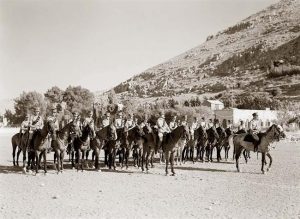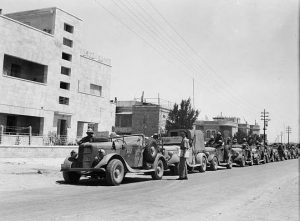Between the Wars
The 8th Hussars returned to England in 1919 and embarked almost immediately for India where they spent less than a year. They were soon ordered to Mesopotamia in order to deal with various native insurrections at Medali, which they put down, moving from there to Egypt. The regiment was re-titled as the 8th King’s Royal Irish Hussars in 1921.
In 1923, they moved back to York and completed a three-year tour as part of the occupation forces in Germany from 1926–1929, when they then returned to Aldershot and received their first motorised transport for the machine-gun squadron.
In 1934, the 8th Hussars moved to Abassia in Egypt.
Their particular brand of soldiering was at an end after 242 years; the 8th King’s Royal Irish Hussars had their horses replaced with 15 Cwt Ford V8 pick-up trucks mounted with Vickers-Berthier machine guns.

8th Hussars, Egypt 1935
The last mounted parade was held at Coombe Hill in the desert near Cairo on 11 November 1935 where the three sabre squadrons and the mounted band “trotted past, wheeled and galloped” for the GOC, Army of the Nile.
In 1936, they helped quell civil unrest in Palestine and then returned to Egypt as part of the Matruh Mobile Force.
In 1938, the 8th Hussars was transferred to the Light Cavalry Brigade of the Mobile Division, (The Matruh Mobile Force) which later became the 7th Armoured Division, nicknamed The Desert Rats. Light tanks were issued in January 1939 as the regiment transferred to the Royal Armoured Corps.
These were cast-offs from the 7th Hussars and the band was converted to an Anti-Tank Troop in 15 Cwt trucks (portees).
Transfer from Cavalry of the Line to the Royal Armoured Corps came in May 1939 as the 8th Hussars prepared for war after the Italian invasion of Albania.
For the first time, black berets were worn as working dress instead of the traditional cavalry “side hat”.

8th Hussars, Palestine 1936
In August 1939, the regiment was sent into the desert to prepare positions at the Mersa Matruh Line.
As part of the preparations, petrol dumps were created by burying supplies in the sand with a piece of wood indicating the burial site and marking the position on maps.

